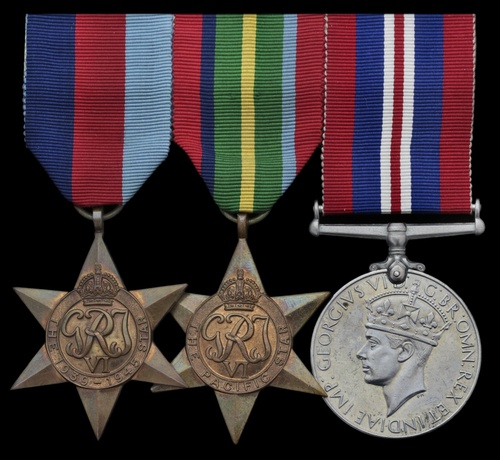
Auction: 22002 - Orders, Decorations and Medals
Lot: 100
(x) Three: Sub-Lieutenant R. K. McE. Angus, Royal Naval Reserve, who was lost aboard the Giang Bee on 13 February 1941
1939-45 Star; Pacific Star; War Medal 1939-45, together with the Admiralty Condolence slip in the name of 'Temporary Sub.-Lieutenant (E) Robert Kenneth McEwan Angus R.N.R.', good very fine (3)
Robert Kenneth McEwan Angus was born in or about 1901, the son of Robert and Enga Florence Angus. He was a Second Engineer in the Merchant Navy. On 1 February 1941 he was commissioned into the Royal Naval Reserve as a Temporary Sub Lieutenant (E). He served under a T124 agreement which was a procedure for officers and men of the merchant marine to be granted temporary combatant status. His next of kin was his mother, then living at 14 St Michael's Road, Singapore.
Angus was originally appointed to the steamer Ban Hong Liong, very likely the ship in which he had been employed as a civilian. By February 1942 he was serving in the Giang Bee. She was a steamship of 1,646 tons, built in 1908 and owned by the Heap Eng Moh Steamship Company of Singapore. Like most local ships, on the outbreak of the war she was taken over by the Royal Navy as an Auxiliary Patrol vessel and armed with a 4-inch gun and depth charges.
On 11 February Giang Bee embarked employees of the Malayan Broadcasting Corporation for evacuation to Java but the Skipper would accept only twenty-five, claiming he was restricted to that by Board of Trade regulations. While his disappointed would-be passengers searched for other escape ships to take them, the ship sailed and was well out into the Roads when she received a signal from the RN Sea Transport Officer recalling her. Despite his protests the Captain was ordered to take on board a further 200 passengers.
Giang Bee made her way down the south east coast of Sumatra, intending to pass through the Banka Strait to Batavia in the Dutch East Indies. For two tense days she made her way across the flat, calm waters until 170 miles south of Singapore, where she was intercepted by two destroyers which approached at high speed. The Captain lowered the white ensign, ordered the women to show themselves on deck, and signalled his intention to surrender. A launch was then despatched from one destroyer but when it was 150 yards from Giang Bee an RAF bomber from Sumatra suddenly appeared and started circling overhead. The Japanese opened fire, the plane flew off, and the enemy launch was recalled. The two destroyers remained about half a mile away with their guns trained on the Giang Bee.
There followed an eerie, uneasy period of waiting as neither side could communicate with the other. As the sun sank into the tropical sea and dusk fell, the destroyers trained their searchlights on her. Around 19:30hrs, the Captain ordered all the women and children to take to the boats. Unfortunately some had been damaged by earlier air-raids; the ropes of one parted as it was being lowered, spilling its occupants into the sea, and another had been holed by splinters and foundered soon after being launched. A swift current swept each boat astern as soon as it was cast off. After the last lifeboat had gone there were still about a hundred people on board.
A party then tried to make contact with the Japanese and rowed a dinghy across but the Japanese refused to receive them and each time the little boat approached one of the destroyers, it would move out of range. At about 22:30hrs one of the destroyers suddenly fired six shells at the Giang Bee. She glowed red from stem to stern and sank in a few minutes. The destroyers then left.
There were seventy survivors including forty-two in one lifeboat which landed in a small bay on the Sumatran coast. Shortly after the lifeboat was beached they were seen by the Tapah, a 200 ton steamship which had been hugging the coast. Although over-crowded, she took off twenty-eight survivors, leaving fifteen to sail the lifeboat to Java which they reached on 8 March, only to find it already in enemy hands.
In the confusion of war, for some time the fate of Angus was unknown. The Admiralty never received any report of his transfer from Ban Hong Liong to the Giang Bee, and there was a report of a Sub-Lieutenant of the same name who had taken passage to Durban. In August 1942 his next-of-kin was notified that he was missing on active service. Evidently his mother escaped from Singapore in time; at that time she was living in Blackpool, Lancashire.
At the end of the war Angus was presumed to have been killed on 13 February 1942. His name is commemorated the Liverpool Naval Memorial.
Subject to 5% tax on Hammer Price in addition to 20% VAT on Buyer’s Premium.
Sold for
£240
Starting price
£200




